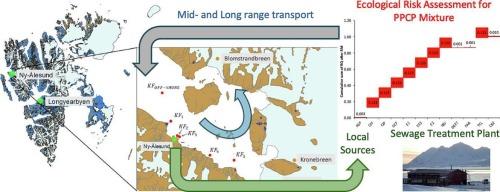高纬度北极峡湾Kongsfjorden(挪威斯瓦尔巴群岛)中人为出现的污染物:发生、来源和风险评估
IF 8
1区 环境科学与生态学
Q1 ENVIRONMENTAL SCIENCES
引用次数: 0
摘要
本研究首次提供了来自Kongsfjorden (KF, Svalbard Archipelago, Norway, 79°00′n, 11°40′e)表层海水中17种药物和个人护理产品(PPCPs)的定量数据,收集时间为五个夏季(2018-2022)。本文还分析了位于KF南岸Ny-Ålesund污水处理厂污水中的ppcp(环丙沙星- cip、恩诺沙星- enr、阿莫西林- amx、红霉素- ery、磺胺甲恶唑- smx、n4 -乙酰磺胺甲恶唑- n4 - smx、卡马西平- cbz、双氯芬酸- dcf、布洛芬- ibu、乙酰水杨酸- asp、对乙酰氨基酚- par、咖啡因- cff、三氯生- tcl、N、N-二乙基-间甲苯酰胺-避蚊胺、雌酮- e1、17β-雌二醇- e2和17α-乙炔雌二醇- ee2)。样品采用固相萃取和液相色谱高分辨率质谱法进行处理。进行环境风险评价(ERA),评价该混合物的生态和抗微生物药物耐药性(AMR)风险以及累积风险。污水中也检测到PPCPs,其中CFF(151.9±8.7 ng/L)和ASP(122.5±9.4 ng/L)的浓度最高。在海水中,主要贡献因子为ASP(39.2±12.9 ng/L)和EE2(32.5±11.9 ng/L),表明受局地排放、峡湾环流以及更广泛的海洋和大气输送的影响。该研究确定CIP、DCF、IBU、CFF、TCL、E1、E2和EE2对北极海洋生态系统有潜在危害。当评估为混合物时,所有化合物都增加了总体风险。抗生素环丙沙星的AMR风险较低。这些发现强调需要加强对ppcp的监测和化学混合物的综合era,以指导管理策略和保护敏感的北极生态系统。本文章由计算机程序翻译,如有差异,请以英文原文为准。

Man-made emerging contaminants in the High-Arctic fjord Kongsfjorden (Svalbard Archipelago, Norway): Occurrence, sources and risk assessment
This study provides the first quantitative data on the presence of 17 pharmaceuticals and personal care products (PPCPs) from various therapeutical classes in surface seawater from Kongsfjorden (KF, Svalbard Archipelago, Norway, 79°00′N, 11°40′E), collected over five summers (2018–2022). The PPCPs (ciprofloxacin-CIP, enrofloxacin-ENR, amoxicillin-AMX, erythromycin-ERY, sulfamethoxazole-SMX, N4-acetylsulfamethoxazole-N4-SMX, carbamazepine-CBZ, diclofenac-DCF, ibuprofen-IBU, acetylsalicylic acid-ASP, paracetamol-PAR, caffeine-CFF, triclosan-TCL, N,N-diethyl-meta-toluamide-DEET, estrone-E1, 17β-estradiol-E2 and 17α-ethinyl estradiol-EE2) were also analysed in sewage from the wastewater treatment plant, serving Ny-Ålesund, located on KF's southern shore. Samples were processed using solid phase extraction and liquid chromatography with high-resolution mass-spectrometry. An environmental risk assessment (ERA) was conducted to evaluate ecological and antimicrobial resistance (AMR) risks and the cumulative risk from the chemical mixture.
PPCPs detected in sewage were also found in seawater, with the highest concentrations in sewage for CFF (151.9 ± 8.7 ng/L) and ASP (122.5 ± 9.4 ng/L). In seawater, the main contributors were ASP (39.2 ± 12.9 ng/L) and EE2 (32.5 ± 11.9 ng/L), suggesting influences from local emissions, fjord circulation, and broader oceanic and atmospheric transport.
The ERA identified CIP, DCF, IBU, CFF, TCL, E1, E2 and EE2 as potentially harmful to the Arctic marine ecosystem. When evaluated as a mixture, all compounds contributed additively to the overall risk. The AMR risk from the antibiotic ciprofloxacin was found to be low.
These findings emphasize the need for enhanced monitoring of PPCPs and comprehensive ERAs of chemical mixtures to guide management strategies and protect sensitive Arctic ecosystems.
求助全文
通过发布文献求助,成功后即可免费获取论文全文。
去求助
来源期刊

Science of the Total Environment
环境科学-环境科学
CiteScore
17.60
自引率
10.20%
发文量
8726
审稿时长
2.4 months
期刊介绍:
The Science of the Total Environment is an international journal dedicated to scientific research on the environment and its interaction with humanity. It covers a wide range of disciplines and seeks to publish innovative, hypothesis-driven, and impactful research that explores the entire environment, including the atmosphere, lithosphere, hydrosphere, biosphere, and anthroposphere.
The journal's updated Aims & Scope emphasizes the importance of interdisciplinary environmental research with broad impact. Priority is given to studies that advance fundamental understanding and explore the interconnectedness of multiple environmental spheres. Field studies are preferred, while laboratory experiments must demonstrate significant methodological advancements or mechanistic insights with direct relevance to the environment.
 求助内容:
求助内容: 应助结果提醒方式:
应助结果提醒方式:


